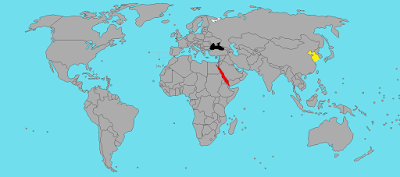1. C. Sea
of Japan and Sea of Okhotsk
"La
Pérouse Strait", or "Soya Strait", is a strait dividing the
southern part of the Russian island of "Sakhalin" from the northern
part of the Japanese island of "Hokkaido", and connecting the "Sea
of Japan" on the west with the "Sea of Okhotsk" on the east. The
strait is named after "Jean-François de Galaup, comte de Lapérouse", a
French Naval officer and explorer, who explored the channel in 1787.
The strait
is 42 km long and 40 to 140 m deep. The narrowest part of the strait is in the
west between Russia's "Cape Krillion" and Japan's "Cape Soya",
which is also the shallowest at only 60 metres.
Japan's
territorial waters extend to three nautical miles into La Pérouse Strait
instead of the usual twelve, reportedly to allow nuclear-armed United States
Navy warships and submarines to transit the strait without violating Japan's
prohibition against nuclear weapons in its territory.
2. A. Iceland
(The Reykjanes Ridge, a portion of the the Mid-Atlantic Ridge
passes across the Þingvellir National Park in Iceland)
Iceland
lies on the divergent boundary between the Eurasian plate and the North
American plate above the Reykjanes Ridge, a portion of the Mid-Atlantic Ridge which
has enough elevation to extend above the sea level.
(The Mid-Atlantic Ridge)
The Reykjanes
Ridge is named after Reykjavík, the capital and largest city of Iceland which is
believed to be the location of the first permanent settlement in Iceland.
3. A.
Port of Aqaba
The
Arabian Sea has been an important marine trade routes since the second
millennium BC. Many major seaports of the world are located here including
Kandla Port, Okha Port, Mumbai Port, Nhava Sheva Port (Navi Mumbai), Mormugao
Port (Goa), New Mangalore Port and Kochi Port in India, the Port of Karachi,
Port Qasim and the Gwadar Port in Pakistan, Chabahar Port in Iran and the Port
of Salalah in Salalah, Oman.
Aqaba (also
known as "Al-Aqabah")
is the only coastal city in Jordan and the largest and most populous city on
the Gulf of Aqaba (a large gulf at the northern tip of the Red Sea, east of the
Sinai Peninsula and west of the Arabian Peninsula) where the Port of Aqaba is
located.
Aqaba has been a major port since the Iron Age. In the early part of
the 20th century, the Aqaba port became particularly important after the
Ottomans built the "Hejaz Railway", which connected the port to Damascus and
Medina.
4. B. Humboldt Current
The
Humboldt Current( also called the Peru Current), is a cold, low-salinity ocean
current that flows north along the western coast of South America. It is an
eastern boundary current flowing in the direction of the equator with a
width of about 900 km. The Humboldt Current is named after the Prussian
naturalist Alexander von Humboldt. In 1846, von Humboldt reported measurements
of the cold-water current in his book "Cosmos".
The current extends from southern Chile (about 45th parallel
south) to northern Peru (about 4th parallel south) where cold, upwelled, waters
intersect warm tropical waters to form the Equatorial Front. Sea surface
temperatures off the coast of Peru, around 5th parallel south, reach
temperatures as low as 16°C, which is highly uncharacteristic of tropical
waters, as most other regions have temperatures measuring above 25°C. Upwelling
brings nutrients to the surface, which support phytoplankton and ultimately
increase biological productivity (accounts for roughly 18-20% of the total
worldwide marine fish catch).
5. C. Labrador Sea
The Arctic Ocean is the smallest and shallowest (also the
coldest) of the world's five major oceans. The "International Hydrographic
Organization" (IHO) recognizes it as an ocean, although some
oceanographers call it the "Arctic Sea".
Located mostly in the Arctic north polar region in the middle
of the Northern Hemisphere, the Arctic Ocean occupies a roughly circular basin
and covers an area of about 14,056,000 km2 surrounded by the land masses of Eurasia,
North America, Greenland and by several islands. It is generally taken to
include Baffin Bay, Barents Sea, Beaufort Sea, Chukchi Sea, East Siberian Sea,
Greenland Sea, Hudson Bay, Hudson Strait, Kara Sea, Laptev Sea, White Sea and
other tributary bodies of water.
The Labrador Sea is a marginal sea of the North Atlantic Ocean
located between the Labrador Peninsula and Greenland. It connects to the north
with Baffin Bay through the Davis Strait.
























































